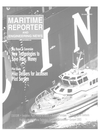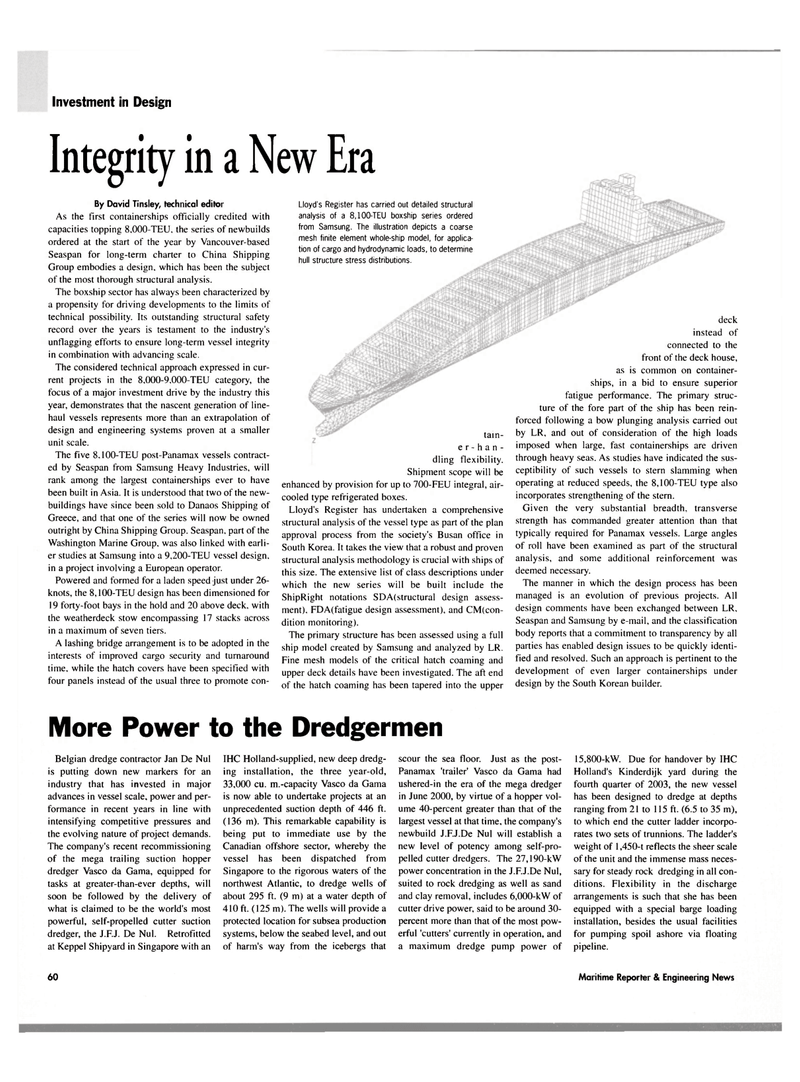
Page 62: of Maritime Reporter Magazine (October 2003)
Read this page in Pdf, Flash or Html5 edition of October 2003 Maritime Reporter Magazine
Investment in Design
Integrity in a New Era
By David Tinsley, technical editor
As the first containerships officially credited with capacities topping 8,000-TEU. the series of newbuilds ordered at the start of the year by Vancouver-based
Seaspan for long-term charter to China Shipping
Group embodies a design, which has been the subject of the most thorough structural analysis.
The boxship sector has always been characterized by a propensity for driving developments to the limits of technical possibility. Its outstanding structural safety record over the years is testament to the industry's unflagging efforts to ensure long-term vessel integrity in combination with advancing scale.
The considered technical approach expressed in cur- rent projects in the 8,000-9,000-TEU category, the focus of a major investment drive by the industry this year, demonstrates that the nascent generation of line- haul vessels represents more than an extrapolation of design and engineering systems proven at a smaller unit scale.
The five 8,100-TEU post-Panamax vessels contract- ed by Seaspan from Samsung Heavy Industries, will rank among the largest containerships ever to have been built in Asia. It is understood that two of the new- buildings have since been sold to Danaos Shipping of
Greece, and that one of the series will now be owned outright by China Shipping Group. Seaspan, part of the
Washington Marine Group, was also linked with earli- er studies at Samsung into a 9,200-TEU vessel design, in a project involving a European operator.
Powered and formed for a laden speed just under 26- knots, the 8,100-TEU design has been dimensioned for 19 forty-foot bays in the hold and 20 above deck, with the weatherdeck stow encompassing 17 stacks across in a maximum of seven tiers.
A lashing bridge arrangement is to be adopted in the interests of improved cargo security and turnaround time, while the hatch covers have been specified with four panels instead of the usual three to promote con-
Lloyd's Register has carried out detailed structural analysis of a 8,100-TEU boxship series ordered from Samsung. The illustration depicts a coarse mesh finite element whole-ship model, for applica- tion of cargo and hydrodynamic loads, to determine hull structure stress distributions. tain- er-han- dling flexibility.
Shipment scope will be enhanced by provision for up to 700-FEU integral, air- cooled type refrigerated boxes.
Lloyd's Register has undertaken a comprehensive structural analysis of the vessel type as part of the plan approval process from the society's Busan office in
South Korea. It takes the view that a robust and proven structural analysis methodology is crucial with ships of this size. The extensive list of class descriptions under which the new series will be built include the
ShipRight notations SDA(structural design assess- ment), FDA(fatigue design assessment), and CM(con- dition monitoring).
The primary structure has been assessed using a full ship model created by Samsung and analyzed by LR.
Fine mesh models of the critical hatch coaming and upper deck details have been investigated. The aft end of the hatch coaming has been tapered into the upper deck instead of connected to the front of the deck house, as is common on container- ships, in a bid to ensure superior fatigue performance. The primary struc- ture of the fore part of the ship has been rein- forced following a bow plunging analysis carried out by LR, and out of consideration of the high loads imposed when large, fast containerships are driven through heavy seas. As studies have indicated the sus- ceptibility of such vessels to stern slamming when operating at reduced speeds, the 8,100-TEU type also incorporates strengthening of the stern.
Given the very substantial breadth, transverse strength has commanded greater attention than that typically required for Panamax vessels. Large angles of roll have been examined as part of the structural analysis, and some additional reinforcement was deemed necessary.
The manner in which the design process has been managed is an evolution of previous projects. All design comments have been exchanged between LR,
Seaspan and Samsung by e-mail, and the classification body reports that a commitment to transparency by all parties has enabled design issues to be quickly identi- fied and resolved. Such an approach is pertinent to the development of even larger containerships under design by the South Korean builder.
More Power to the Dredgermen
Belgian dredge contractor Jan De Nul is putting down new markers for an industry that has invested in major advances in vessel scale, power and per- formance in recent years in line with intensifying competitive pressures and the evolving nature of project demands.
The company's recent recommissioning of the mega trailing suction hopper dredger Vasco da Gama, equipped for tasks at greater-than-ever depths, will soon be followed by the delivery of what is claimed to be the world's most powerful, self-propelled cutter suction dredger, the J.F.J. De Nul. Retrofitted at Keppel Shipyard in Singapore with an
IHC Holland-supplied, new deep dredg- ing installation, the three year-old, 33,000 cu. m.-capacity Vasco da Gama is now able to undertake projects at an unprecedented suction depth of 446 ft. (136 m). This remarkable capability is being put to immediate use by the
Canadian offshore sector, whereby the vessel has been dispatched from
Singapore to the rigorous waters of the northwest Atlantic, to dredge wells of about 295 ft. (9 m) at a water depth of 410 ft. (125 m). The wells will provide a protected location for subsea production systems, below the seabed level, and out of harm's way from the icebergs that scour the sea floor. Just as the post-
Panamax 'trailer' Vasco da Gama had ushered -in the era of the mega dredger in June 2000, by virtue of a hopper vol- ume 40-percent greater than that of the largest vessel at that time, the company's newbuild J.F.J.De Nul will establish a new level of potency among self-pro- pelled cutter dredgers. The 27,190-kW power concentration in the J.F.J.De Nul, suited to rock dredging as well as sand and clay removal, includes 6,000-kW of cutter drive power, said to be around 30- percent more than that of the most pow- erful 'cutters' currently in operation, and a maximum dredge pump power of 15,800-kW. Due for handover by IHC
Holland's Kinderdijk yard during the fourth quarter of 2003, the new vessel has been designed to dredge at depths ranging from 21 to 115 ft. (6.5 to 35 m), to which end the cutter ladder incorpo- rates two sets of trunnions. The ladder's weight of 1,450-t reflects the sheer scale of the unit and the immense mass neces- sary for steady rock dredging in all con- ditions. Flexibility in the discharge arrangements is such that she has been equipped with a special barge loading installation, besides the usual facilities for pumping spoil ashore via floating pipeline. 60 Maritime Reporter & Engineering News

 61
61

 63
63
